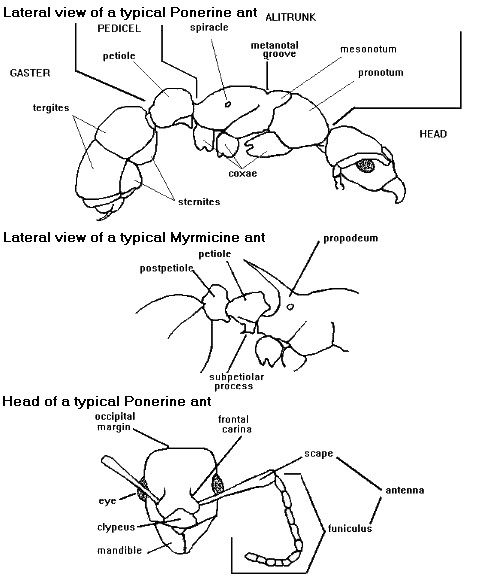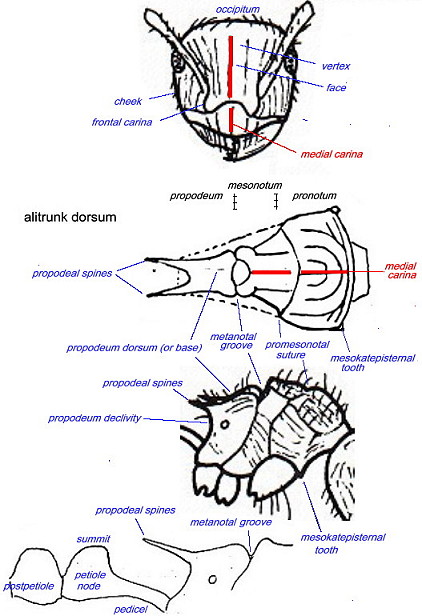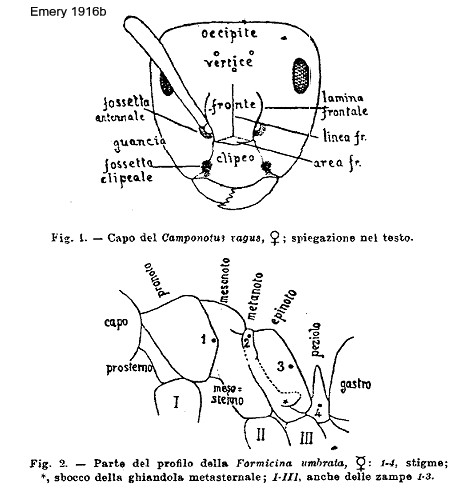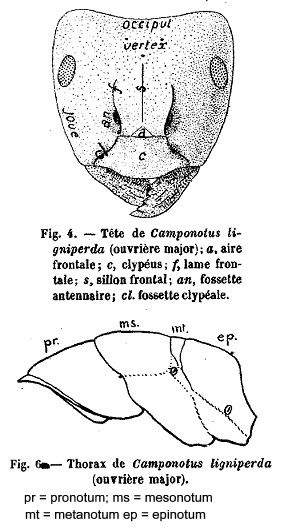Glossary
| The Ants of
Egypt Glossary |
My drawings (labelled BT plus date of digitisation) were of specimens mounted on card points. I attempted to blend accuracy (of what I felt were diagnostic details) and artistic impression (to convey something of the general appearance of the specimen). They were drawn as seen under a WILD M5 stereomicroscope fitted with a camera lucida type drawing tube, and using incident illumination from a WILD low voltage source. The original drawings were made in black Indian ink on art paper. The magnification chosen for any one species was generally such that the whole ant could be seen filling a single field of vision, and an (approximate) scale is indicated on each drawing. My drawings are all labelled with BT . To ensure access to older figures, I have included numeorus drawings culled from historic publications, all are clearly labelled as to source.
To further aid identification, brief descriptive notes are given,
together with the following measurements (all in mm):
Total Length, TL, when outstretched from mandibular apex to
gastral apex;
Head Length, HL, in a straight line from anterior clypeal margin
to the mid-point of the occiptal margin;
Head Width, HW, maximum width (usually behind the eyes in
full-face view);
Scape Length, SL, straight line length from base to apex,
excluding any basal constriction;
and Pronotal Width, PW, maximum width in dorsal view.
In some instances calculation of comparative measurements is necessary,
for example,
Scape Index, SI = (SL X 100)/HW ; Cephalic Index, CI = (HW X
100)/HL ; Ocular Index, OI = (EL X 100)/HW [EL is eye length].
The differentiation of species using dichotomous keys uses a number of body parts as the defining elements. Most of the body parts are shown in the labelled drawings, others are listed below. The glossary draws on Bolton (1973a) and Bolton & Collingwood (1975).
Some recent authors use the term "mesosoma" for the alitrunk. I (BT)
feel that is misleading because translated mesosoma = middle body and
you cannot have a middle to an organism with at least four visually
separable parts (five on ants with the pedicel divided into petiole and
post-petiole). Technically also the propodeum and pedicel are
part of the archaic posterior of the insect body.
 |
 |
Taxonomic terms
In some early description the body length is expressed in terms of "lines"
- these were 1/12 of imperial inch; 1 line = 2.117 mm
The word hair is used throughout rather than the more traditional
seta (plural setae). I (BT) feel the latter should be reserved for the stout structures on the legs of many ants.
Acidopore - a circular or subcircular orifice formed by the apex
of the hypopygium (last visible gastral segment) in the subfamily
Formicinae.
Antennal scrobe - a longitudinal depression in the side of the
head, either above or below the eye, which can accommodate the scape or
the whole of the antenna.
Carina (te) - ridge (ridged or furnished with a raised
line or keel).
Clavate clubbed or enlarged at the tip.
Costulate - in narrow ridges.
Crenulate - finely notched or scalloped.
Denticulate - with minute tooth-like projections.
Emarginate - notched, with a piece of any shape cut from the
margin.
Falcate - bent or curved like a sickle.
Flagellate - whip-like, often wavy.
Fovea - small depression or pit.
Gena the cheek.
Geniculate - abruptly bent, elbowed.
Gula (r surface) - the median underpart of the head.
Lamella - leaf-like plate.
Pectinate - with branches like a comb.
Pilosity - hairiness (especially covered with soft, flexible
hair).
Punctate - with fine punctures or pits.
Pygidium - the last visible gastral tergite.
Reticulate - meshed, like network.
Rugose - marked by rugae or wrinkles.
Spatulate - with broadly elongated apex.
Squamiform - having the shape of a scale.
Striate - in fine ridges or lines.
Suborbicular - hairs with rounded apices.
Trifid - split in three by deep clefts as notches.

 Italian
to English - Emery (1916b: 88-90) defined taxonomic terms in Italian;
his images for workers are right.
Italian
to English - Emery (1916b: 88-90) defined taxonomic terms in Italian;
his images for workers are right.
French to English
In translating papers originally written in French, I have used the terms
as follows:-
arêtes = ridge, edge or flange;
arqué = arcuate;
arrondi = rounded;
atténué = attenutated (less extreme);
comprimé = compressed;
dressée = raised;
effacée = faint (eroded);
épais = thick (wide);
épinotum = epinotum, modern usage = propodeum;
fossette = hair pit (or punctule);
inermes = rounded, i.e. not a distinct spine;
lisses = smooth, polished;
massue = antennal club;
rides = rugae (wrinkles), hence rideé = rugose;
sillon = post-clypeal notch;
trapue = thick-set (stocky) in build or appearance.
German to English
Soldat = soldier or major
Anatomy:- Kopf = head; Netzaugen = eye; Schaft =
scape; Fühler = feeler = antenna; Fühlergrube =
antennal scrobe (feeler groove = scrobe); Stirnleiste = frontal
carina; Geissel = whip, funiculus; Körper = body;
Körperlange = body length TL; Basalfläche =
dorsum of propodeum (metanotum); Höcker = hump; Knoten
= knot (pedicel); Schenkel = femur (shank); Bauch = belly,
abdomen, gaster; Querwulst = transverse welt, scutellum (quer =
tranverse); Querleiste = transverse ridge/ledge; Dorn(en)
= thorn; Dörnchen = spine; Zahn = tooth; Haar
= hair; Punkt(e) = puncture, point, pit; Punktiert =
puncturation; netzartig = reticulate; Stielchenglied =
pedicel (Glied = link);
so = as; genetzt = general; doppelt = double
hinter = hind; mitte = mid-; erste = first; zweite
= second; dreimal = three times, dritte = third; viertel
= fourth (quarter)
längsrichtung = longitudinal; längsgestrieft =
longitudinally striate
kurz = short; lang = long; gross = large; breit
= broad; dick = fat, thick; dicker = thicker; dichter
= dense; am stärksten = strongest; gewölbt =
vaulted; niedergrückt = depressed; stumpf = blunt;
gerundet = rounded; spitzwinklig = acute (sharp
angle/point); rechtwinklig = right-angled; glänzend =
shiny
Allometric growth - differential growth, usually with regular
ratios of body parts in different morphs (as in Dorylus).
Claustral - colony founding by a fertilised female living in
seclusion and feeding the first members of her colony.
Commensal - species which feed upon the food supplies of another
species but without harming the host species.
Dichthadiigyne - a special type of female in some types of ant
which are wingless, without ocelli and capable of periodic enlargement of
the gaster and a high reproductive output.
Epigaeic - a species living on the surface of the earth or
arboreally.
Ergatoid or Ergatogyne - a worker-like female, wingless
and usually capable of laying eggs.
Hypogaeic - adapted to an underground mode of existence, with or
without surface activity.
Legionary - predation combined with nomadism, found in some
ponerines and dorylines.
Monogyny - having only one queen per colony.
Trophallaxis - exchange of food or other substances between
members of a colony of social insects.
Trophosphere - area in which food is available to a colony.
| ©2005,
2006, 2015, 2019 - Brian Taylor CBiol FRSB FRES 11, Grazingfield, Wilford, Nottingham, NG11 7FN, U.K. |
href="glossary.htm"